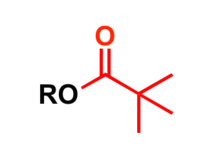Pivalic acid
| |||
| Names | |||
|---|---|---|---|
| Preferred IUPAC name
2,2-Dimethylpropanoic acid | |||
| Other names
Pivalic acid Dimethylpropanoic acid Neopentanoic acid Trimethylacetic acid | |||
| Identifiers | |||
| 75-98-9 | |||
| 3D model (Jmol) | Interactive image | ||
| ChEBI | CHEBI:45133 | ||
| ChEMBL | ChEMBL322719 | ||
| ChemSpider | 6177 | ||
| ECHA InfoCard | 100.000.839 | ||
| PubChem | 6417 | ||
| |||
| |||
| Properties | |||
| C5H10O2 | |||
| Molar mass | 102.132 g/mol | ||
| Density | 0.905 g/cm3 | ||
| Melting point | 35 °C (95 °F; 308 K) | ||
| Boiling point | 163.7 °C (326.7 °F; 436.8 K) | ||
| Related compounds | |||
| Related compounds |
neopentyl alcohol neopentane | ||
| Except where otherwise noted, data are given for materials in their standard state (at 25 °C [77 °F], 100 kPa). | |||
| | |||
| Infobox references | |||
Pivalic acid is a carboxylic acid with a molecular formula of (CH3)3CCO2H. This colourless, odiferous organic compound is solid at room temperature. The acronym for pivalate is Piv[1] & for pivalic acid it is PivH.
Preparation
Industrial route
Pivalic acid is prepared by hydrocarboxylation of isobutene via the Koch reaction:
- (CH3)2C=CH2 + CO + H2O → (CH3)3CCO2H
Such reactions require an acid catalyst such as hydrogen fluoride. tert-Butyl alcohol and isobutyl alcohol can also be used in place of isobutene. Globally, several million kilograms are produced annually.[2] Pivalic acid is also economically recovered as a by-product from the production of semi-synthetic penicillins like ampicillin and amoxycillin.
Laboratory methods
It was originally prepared by the oxidation of pinacolone with chromic acid[3] and by the hydrolysis of tert-butyl cyanide.[4] Convenient laboratory routes proceed via t-butyl chloride via carbonation of the Grignard reagent[5] and by oxidation of pinacolone.[6]
Applications
Relative to esters of most carboxylic acids, esters of pivalic acid are unusually resistant to hydrolysis. Some applications result from this thermal stability. Polymers derived from pivalate esters of vinyl alcohol are highly reflective lacquers. The pivaloyl (abbreviated piv or pv) group is a protective group for alcohols in organic synthesis. Pivalic acid is sometimes used as an internal chemical-shift standard for NMR of aqueous solutions. While DSS is more commonly used for this purpose, the minor peaks from protons on the three methylene bridges in DSS can be problematic. On a 1H NMR spectrum at 25 °C and neutral pH, pivalic acid gives a singlet at 1.08 ppm.
Safety
Like most carboxylic acids pivalic acid is a mild irritant and only weakly toxic (oral LD50 = 900 mg/kg for rats).
Alcohol protection
Pivaloyl (Pv) group is used as a protecting group in organic synthesis. See for example, in Sivelestat.

Most common protection methods

- Pivaloic anhydride with Sc(OTf)3 or VO(OTf)2
Most common deprotection methods
- Tetrabutylammonium hydroxide (Bu4NOH) at ambient temperatures[8]
- Treatment with aqueous methylamine (MeNH2)[9]
- Pivaloate esters can be cleaved with strong bases:
- 0.5N sodium hydroxide (NaOH) in ethanol/water solution[10]
- Potassium carbonate (K2CO3) or sodium methoxide (NaOMe) in methanol[11]

- Methyl lithium (MeLi) in ether
- Potassium tert-butoxide in water
References
- ↑ http://www.springer.com/cda/content/document/cda_downloaddocument/Abbreviations+9781849730549.pdf?SGWID=0-0-45-932039-p174009688
- ↑ Wilhelm Riemenschneider "Carboxylic Acids, Aliphatic" in Ullmann's Encyclopedia of Industrial Chemistry, 2002, Wiley-VCH, Weinheim. doi:10.1002/14356007.a05_235.
- ↑ Friedel and Silva, Ber. 6, 146, 826 (1873).
- ↑ Butlerow, Ann. 165, 322 (1873).
- ↑ S. V. Puntambeker, E. A. Zoellner, L. T. Sandborn, and E. W. Bousquet (1941). "Trimethylacetic acid from tert.- Butyl Chloride". Org. Synth.; Coll. Vol., 1, p. 524
- ↑ L. T. Sandborn and E. W. Bousquet (1941). "Trimethylacetic acid from Pinacolone". Org. Synth.; Coll. Vol., 1, p. 524
- ↑ Robins, Morris J.; Hawrelak, S. D.; Kanai, Tadashi; Siefert, Jan Marcus; Mengel, Rudolf (1979-04-01). "Nucleic acid related compounds. 30. Transformations of adenosine to the first 2',3'-aziridine-fused nucleosides, 9-(2,3-epimino-2,3-dideoxy-.beta.-D-ribofuranosyl)adenine and 9-(2,3-epimino-2,3-dideoxy-.beta.-D-lyxofuranosyl)adenine". The Journal of Organic Chemistry. 44 (8): 1317–1322. doi:10.1021/jo01322a026. ISSN 0022-3263.
- ↑ van Boeckel, C. A. A.; van Boom, J. H. (1979-01-01). "Synthesis of glucosylphosphatidylglycerol via a phosphotriester intermediate.". Tetrahedron Letters. 20 (37): 3561–3564. doi:10.1016/S0040-4039(01)95462-0.
- ↑ Griffin, B. E.; Jarman, M.; Reese, C. B. (1968-01-01). "The Synthesis of oligoribonucleotides—IV". Tetrahedron. 24 (2): 639–662. doi:10.1016/0040-4020(68)88015-9.
- ↑ Ogilvie, Kelvin K.; Iwacha, Donald J. (1973-01-01). "Use of the tert-butyldimethylsilyl group for protecting the hydroxyl functions of nucleosides". Tetrahedron Letters. 14 (4): 317–319. doi:10.1016/S0040-4039(01)95650-3.
- ↑ Paquette, Leo A.; Collado, Iván; Purdie, Mark (1998-03-01). "Total Synthesis of Spinosyn A. 2. Degradation Studies Involving the Pure Factor and Its Complete Reconstitution". Journal of the American Chemical Society. 120 (11): 2553–2562. doi:10.1021/ja974010k. ISSN 0002-7863.

